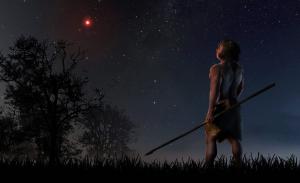Blog
Stellar Visitor
25 May 2020
 José A. Peñas/SINC
José A. Peñas/SINCStars wander. Our Sun drifts through the galaxy as it orbits galactic center, and the other stars do as well. This is true of all the stars in the galaxy, and it means sometimes their paths can cross. Collisions are extremely rare, but stars can often have very close neighbors for a time.
This has happened with the Sun in the past. About 70,000 years ago a small red dwarf star known as Scholz’s Star came within 50,000 astronomical units of the Sun. That’s less than a quarter the distance of the currently closest star, Proxima Centauri. While that is cosmically close, it didn’t have an effect on the solar system. Computer simulations show that a star would need to get much closer to start affecting the orbits of solar system bodies in any significant way.
It’s estimated that about two stars make a close approach to the Sun ever million years. Narrowing it down to specific stars and their closest approach is more difficult. Until very recently, the precise motion of nearby stars relative to the Sun has been hard to pin down. But now that the Gaia spacecraft has been making a survey of more than a billion stars, we’re starting to get some real data.
Most of the close approaches in the future are similar to that of Scholz’s Star, but there is one that will be much closer. Recently in Astronomy & Astrophysics a team found that Gliese 710 will come within 10,000 AU of the Sun.1 That’s closer than the outer edge of the Oort Cloud, and it means the encounter could trigger a flux of cometary bodies into the inner solar system.
The good news is that Gliese 710 won’t make its visit for 1.4 million years. If humanity is still around, we’ll have plenty of time to prepare. We might even pay our new neighbor a visit.
Berski, Filip, and Piotr A. Dybczyński. “Gliese 710 will pass the Sun even closer-Close approach parameters recalculated based on the first Gaia data release.” Astronomy & Astrophysics 595 (2016): L10. ↩︎